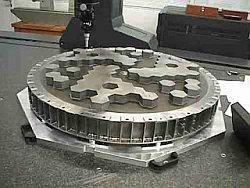 Coded-Aperture Masks
Coded-Aperture Masks

Coded Apertures or Coded-Aperture Masks are grids, gratings, or other patterns of materials opaque to various wavelengths of light. They are used -coupled to detectors- in the field of high energy astronomy, because their high energies pass through normal lenses and mirrors.
In a coded-aperture-based telescope, there's a "mask" mounted at a distance above the detectors with small lead tiles glued to it in a known pattern. There are also open areas on the mask. Gamma rays hitting the lead tiles are stopped, but those going through the open areas continue on. Then, the scientists measure the pattern of gamma rays at the detector plane, and using computer algorithms to deconvolve, or isolate, the patterns. This can provide the location of the gamma-ray source in the sky. The advantage of this technique is that it can observe a broad patch of sky, so after the decade of 1990's, virtually every gamma-ray instrument that was flown used it.
Among the several instruments and telescopes flown in satellites and stratospheric balloons that used this technique we can mention: ProtoEXIST (Energetic X-ray Imaging Survey Telescope), TIMAX (Telescopio Imageador de Raios X), MASCO (MAScara COdificada), TXC (Transient X-RAY Camera) and GRIP (Gamma Ray Imaging Payload).

